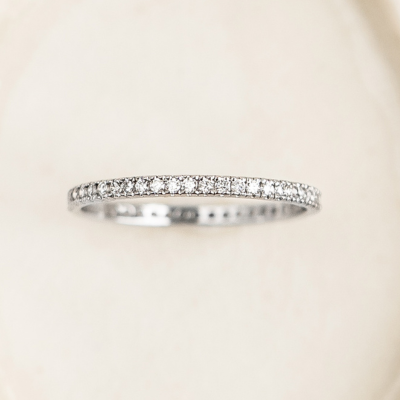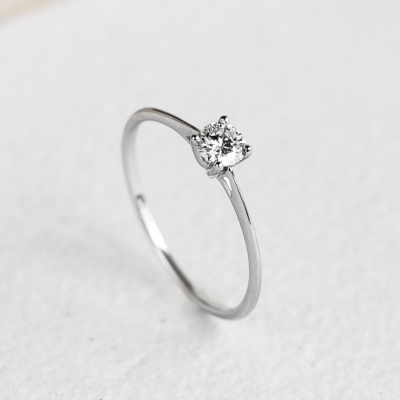What is White Gold? Your Complete Guide | Linjer Jewelry
What is white gold? Is it actually gold? How is it made? What does white gold jewelry pair with? Taking the world of jewelry by storm at the beginning of the 20th century, white gold quickly became a darling of jewelry makers and jewelry wearers alike.
This luminous gold metal alloy has a silvery-white hue—a favorite of those who prefer their jewelry in moonlit tones. In this easy-to-read article, you’ll find everything you’ve ever wanted to know about white gold and how to wear it with class.
What is White Gold?
White gold is an alloy which combines pure gold with other white metals such as palladium or silver to create a silvery-white-toned precious metal. The different metals are melted together to form a mixture that is evenly blended, resulting in a consistent uniform color throughout the alloy. The exact ratio of gold to white metals will ultimately influence its overall color and durability. Similar in appearance to both platinum and silver, white gold has its own allure that makes it a desirable choice in the world of fine jewelry.
Shop Our 14k White Gold Jewelry
Is White Gold Real Gold?
Yes, white gold is indeed real gold. It is an alloy composed of pure gold and white metals such as palladium or silver. The resulting mixture gives the precious metal a white-silvery color. While the amount of gold in white gold can vary, it is still considered a precious metal and is a popular choice for jewelry due to its graceful appearance, versatility, durability and strength!
What is White Gold Made of?
White gold is made of pure gold and at least one other white-toned metal, such as silver or palladium. The compound can also include copper or zinc. The other metals in the precious metal alloy is what gives white gold its “white” or “silver” appearance.
High quality white gold is sometimes plated with rhodium, a durable metal with a bright, silver hue, which can help create a protective outer layer.
The composition of white gold alloy can vary. 14-karat white gold, for example, is 58.3% gold and 41.7% other metals. 18-karat white gold is 75% gold and 25% other metals.
Why are alloy metals added to white gold?
Alloy metals are mainly added to white gold to give it its eponymous color—white. Since, the natural hue of gold is yellow, without those white-toned alloy metals, white gold wouldn’t be “white” at all. So, it’s necessary to add other metals in order to create the desired hue.
Originally, white gold was envisioned as an alternative to the luxurious yet pricey platinum. While alloy metals are added to white gold mainly in order to create its gorgeous silvery color, it has a few other added benefits: alloy metals can affect the malleability of gold, making it easier to work with and more resistant to scratches and wear—perfect for jewelry. Not to mention, the addition of alloy metals makes white gold more affordable. Pure gold is very expensive and impractical to wear.
Shop our 14k White Gold Jewelry
Is White Gold Worth More Than Yellow Gold?
White gold can be worth more—or less—than yellow gold; the value of gold, white or yellow, depends on several factors, including proportion, plating, production, and principle alloy metals. Let’s break that down, starting with proportion: 18k white gold, for instance, would probably be worth more than 10k yellow gold. However, the alloy metal also plays a key role in the value of the piece. Pure gold that is alloyed with silver and copper might be worth more than white gold that is alloyed with nickel. Likewise, the plating can also play a part. Rhodium, currently the most expensive precious metal, is often used to coat white gold, and depending on the thickness of the coating, it could significantly increase the value of a white gold piece.
Finally, producing white gold is slightly more complex than producing yellow gold, which could be reflected in the price point. Each gold piece—white or yellow—has a different value depending on its unique set of factors.
How Much Pure Gold Is in Your White Gold Jewelry?
The amount of pure gold found in white gold jewelry depends on the karats. Karatage is the standard used to measure the amount of pure gold found in any gold compound (white or yellow). In order to be officially labeled as “gold” (in the U.S.), gold alloy must contain at least 10 karats, with 24 karats being pure gold. Let’s break it down:
- 10 karats (10 out of 24) = 41.7% pure gold
- 14 karats (14 out of 24) = 58.3% pure gold
- 18 karats (18 out of 24) = 75% pure gold
- 22 karats (22 out of 24) = 91.7 pure gold
- 24 karats (24 out of 24) = 99.9% pure gold
The Advantages of White Gold
There are a few great advantages to choosing white gold including value, longevity, and color.
- Value: White gold that is made with precious metals like silver, palladium, and rhodium has an inherently high worth, yet is more affordable than pure platinum jewelry, a coveted metal of the same tone.
- Longevity: White gold, especially when coated with rhodium, is not prone to scratching and is resistant to wear and tear, making it a good long-term choice.
- Color: Many people like the longevity and value of gold jewelry but are not fond of its yellowish hue. If you’re looking for a soft color to compliment your wardrobe or skin tone, white gold is a great choice!

The Disadvantages of White Gold
While white gold has its advantages, it also has a few drawbacks in terms of maintenance, metal traits, and price.
- Maintenance: White gold isn’t naturally “white”; it’s actually a pale, silvery gold—the result of combining gold with white metals. And, while some people love that unique combination, if you like the deep, cool tone of many white gold pieces, you’ll need to maintain its rhodium plating, which is what gives it that striking silvery color.
- Metal traits: Depending on the combination of metals used in the white gold alloy, you might end up with an alloy that is prone to scratching or one that gives you allergies if it has a high nickel content!
- Cost: Believe it or not, white gold can be expensive. Due to the extra steps needed to achieve the pale coloring and the sometimes pricey precious metals used in the alloy, some white gold pieces can come with a steep price tag.
Is White Gold More Expensive Than Yellow Gold?
The price of white gold is subject to several factors and can, therefore, be more or less expensive than yellow gold jewelry. Both metals will vary in price depending on the karatage (or amount of pure gold), the value of the alloy metals used, and the market demand for either type of metal. In addition, white gold can have some added costs associated with production included in the price tag. In the end, it all depends.
Generally, the higher the karatage and the more valuable the alloy metals, the higher the price—this goes for both yellow and white gold!
Does White Gold Tarnish?
While pure gold doesn’t tarnish, white gold can tarnish due to the other metals mixed into the gold alloy. A white gold alloy with a high percentage of pure gold, such as 18k gold, is less quick to tarnish. Also, white gold is often coated with a hard, corrosion-resistant outer layer of rhodium, which protects the gold alloy metals underneath from exposure to oxygen and other elements that speed up the tarnishing process. To keep your white gold jewelry tarnish-free, be sure to choose a high-quality, nickel-free white gold, and keep it clean and dry—the same way you care for all of your jewelry!
Does White Gold Scratch?
In short, yes, your white gold is susceptible to scratches. That said, there are a few different factors that come into play when determining how susceptible white gold is to scratches. Remember, the closer the gold karatage is to 24k (pure gold), the softer it is. So, white gold alloys with high karatage are going to reveal those nicks and dings. When mixed with a higher percentage of hard base metals, white gold is less likely to scratch. Plus, a plating of super strong rhodium—a common practice for white gold—will add an extra layer of protection. The same best practices apply to white gold as to any other jewelry: to avoid scratches, be careful when layering and when storing your jewelry, and invest in replating every few years.
Can You Shower With White Gold?
You can shower with white gold, but it’s not recommended. We all know that can and should are two different things. And, as magical as the starry hue of this lustrous metal is, it doesn’t have magic superpowers. If your white gold piece has rhodium plating, it will probably protect it through a few extra years. If your white gold piece doesn’t have rhodium plating, water exposure increases the rate of tarnish—not to mention exposure to chlorine and other chemicals found in your soaps and shampoos. So, yes, you can shower with white gold, but you’d probably be better off avoiding it.
Should I Buy White Gold?
Yes - you should buy white gold! White gold has become a popular choice for those who love soft, silvery tones. Choosing the right metal for your jewelry is, of course, a matter of personal penchant, but you can use this guide to help you weigh the advantages and disadvantages of white gold and to aid you in deciding if it’s right for you!
Remember, if you're looking for timeless, luxury-quality jewelry to add to your wardrobe, we’ve got you covered. At Linjer, we love the tried-and-true. Our white gold pieces have been alloyed with silver and plated with rhodium for extra strength and durability. Check out our stunning range of white gold earrings and rings in our 14k solid gold collection page.


















